Movie Review – Forbidden Planet
While it may feel a little clunky by modern standards, there’s no denying the manner in which Forbidden Planet influenced science fiction films ever since. The visuals remain pretty awesome considering the vintage of the film, and the concept is pretty fun, even if today’s audiences will find the acting somewhat stiff and hammy, and Robbie The Robot’s first appearance might be something of a headscratcher – all that taken into account, Forbidden Planet is still a fun watch for what it is.
– Summary –
Director : Fred M Wilcox
Year Of Release : 1956
Principal Cast : Leslie Nielsen, Walter Pigeon, Anne Francis, Jack Kelly, Warren Stevens, Earl Holliman, Richard Anderson, Robby The Robot.
Approx Running Time : 98 Minutes
Synopsis: Twenty years after a starship of colonists landed on a distant world, Earth’s military has decided to send a reconnaissance vessel to land on Altair IV, to discover what happened to the crew. Upon landing, the ships crew, led by Commander John Adams, learn that the crew of the long-lost ship were all but wiped out, with only an elderly scientist and his young daughter remaining alive. A mysterious monster wiped out most of the crew years ago, and with the arrival of the new space craft, that once-forgotten creature now returns to wreak havoc.
What we think : While it may feel a little clunky by modern standards, there’s no denying the manner in which Forbidden Planet influenced science fiction films ever since. The visuals remain pretty awesome considering the vintage of the film, and the concept is pretty fun, even if today’s audiences will find the acting somewhat stiff and hammy, and Robby The Robot’s first appearance might be something of a headscratcher – all that taken into account, Forbidden Planet is still a fun watch for what it is.
**********************
I’m not an expert on 50’s cultural milestones, nor am I an expert on film prior to 1970, but I will say that the title logo of this review is stunningly inaccurate – even if it is one of Hollywood’s most iconic film images. Yes, Forbidden Planet has a robot in it, and it does look like the image above, but at no stage does said robot ever carry a near-nude hottie across the surface of a planet as depicted. Those of you seeking titillation might best be served returning to RedTube. Forbidden Planet is, to avoid hyperbole, a genuine Hollywood classic. By today’s standards, it’s badly dated in certain aspects, but that doesn’t preclude modern audiences from taking something out of it. Forbidden Planet has two things going for it – first, the starring turn of Leslie Nielsen in a rare straight role (yes, the same Leslie Nielsen who made Frank Drebin famous in those Naked Gun films!) and second, the sexy Anne Francis as the films resident love interest. Sure, it’s got special effects aplenty – and most of those are pretty decent even by today’s standards! – and the towering presence of Walter Pidgeon alongside superstar robot Robby, but for me, the real gold in this film is the central role of Nielsen and the smouldering turn of Francis. While today’s films may outclass Forbidden Planet in almost every way, this film could easily be the progenitor of much of modern cinemas science fiction foundation.
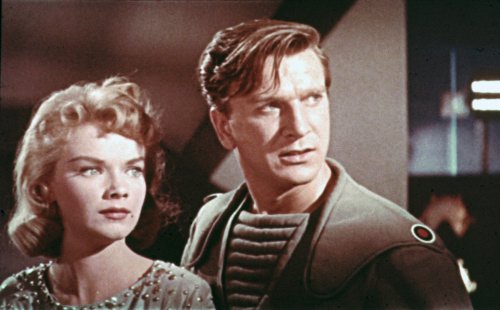
It is the 23rd Century, and at the time we pick up the story, United Planets Cruiser C57-D is on its way to Altair IV to discover the fate of an expeditionary ship sent there over 20 years prior – an expedition which until now has never been heard of since. Commander John Adams (Leslie Nielsen) is the no-nonsense officer in charge of C57-D, and upon making contact with the planet’s surface, is told in no uncertain terms that their presence is unwanted and potentially dangerous. Unheeding, Adams commands the ship to land, which it does, and the crew are soon met by a giant metallic robot, designated Robby, who takes Adams and two of his officers, Farman (Jack Kelly) and Doc Ostrow (Warren Stevens) to see Doctor Morbius (Walter Pidgeon), the last human man alive from the expeditionary force. Morbius explains that after his ship, the Bellerophon, landed on Altair IV, the crew were eventually all killed off by a mysterious invisible monster – a monster which has since vanished and not been seen in decades. Morbius’s young daughter, Alta (Anne Francis) is inexperienced with men (both emotionally and sexually) and is soon hit-on by members of the crew of the C57-D – ultimately, she falls for Adams (he pulls rank on another of the crew! What a bastard!) and Alta decides that staying on Altair IV might not be the best thing for her. Meanwhile, Doctor Morbius explains to Adams that his research of the previous inhabitants of Altair IV has led to some remarkable science breakthroughs, and that the Krell died out almost as soon as their technology reached a point at which they could tap into almost unlimited power. Soon, the mysterious monster which killed the Bellerophon crew returns, killing various members of Adams’ own crew, before a showdown at Morbius’s residence leads Adams to make a stunning conclusion.
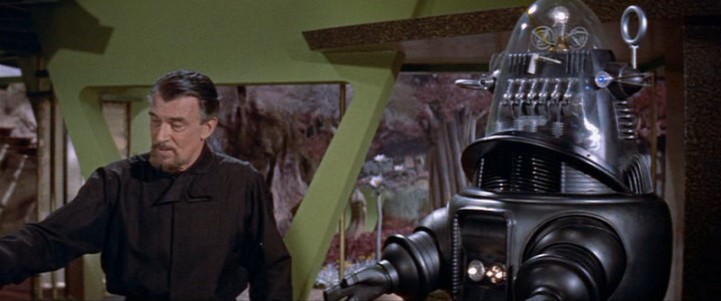
Anybody reading this who has little experience with films made prior to the late 60’s or early 70’s will probably take one look at the trailer for this on YouTube and click onwards, seeking out the next Adam Sandler debacle before you bother with Forbidden Planet. Those of you with a low tolerance for simple, often clunky storytelling methods will probably do the same, for if there’s one thing you can describe Forbidden Planet as, it’s clunky. From a technical perspective (more on this later) the film is amazing, but the sheer 50’s-ness of it all overrides some of the story’s more powerful moments. The acting is perhaps the key element here which will put a lot of younger folks off – as with a lot of films of the period, its resolutely stagey and lacking in rapid editorial protocol. Entire scenes are filmed using a wide-shot, with only momentary reaction shots being inserted where needed to cover a cut or alternative take, and I admit that even I, with my fairly limited exposure to films of this period, found it somewhat tough going at times. Director Fred M Wilcox, whose previous work included Lassie Come Home and The Secret Garden (1949), helms this feature with one eye on the amazing visual effects, and another on maximizing the screen time of his stunning leading lady. While the dialogue feels wooden and stilted, even when delivered fluidly by Leslie Nielsen and screen legend Walter Pidgeon, the focus of the film seems to be the special effects, with an extended sequence of explanatory dialogue by Pidgeon about the Krell technology obviously intended to bulk out the films running time and increase the dazzling visuals for the audience. At least Wilcox knew to give the punters their money’s worth!
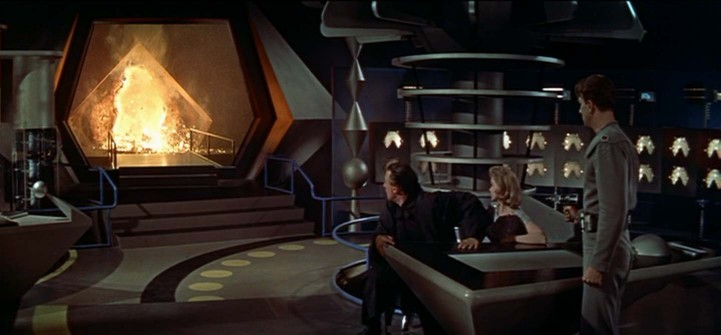
The supporting cast in this film are, to my eyes, virtually devoid of character – the “crew” of the C57-D feel like a whole bunch of Star Trek redshirts running about the studio soundstage – the horrific blue uniforms and stodgy pseudo-militaristic dialogue they are given is of the period, certainly, yet stilted and generic in the majority of cases. About the only real character we meet outside of Adams, Morbius and Alta, is the ships cook, played by Earl Holliman, who does a good job as what can only be described as Forbidden Planet’s comic relief. Leslie Nielsen delivers the most heroic performance of his career as Adams, and you can see he has a genuine screen presence – he knows how to work a scene and deliver the lines so they sound real, as opposed to his fellow supporting cast, who sound like they’re reading the lines from a cur-card half the time. Walter Pidgeon skims the surface of his role, delivering the lines with aplomb but missing a crucial sense of motivation in his character; Morbius isn’t evil, nor is he vindictive, yet he does feel a little selfish in his actions, and the reasoning behind this is thin at best. The only female in the film, Anne Francis, is… well, she’s hot. Her costume leaves very little to the imagination, and while she may have been included to bring sexy back to the film, there’s no denying her sheer magnetic screen personality. The camera loves her, and Wilcox ensures she’s lit and filmed in only the most flattering ways. Francis’ chemistry with Nielsen is palpable, but their dialogue is not, much like that between Hayden Christensen and Natalie Portman in George Lucas’s Star Wars prequels. Truthfully, the relationship between Alta and Adams goes from sly glance to outright love within about three minutes of film time, and it strains credulity that audiences just accepted it at the time. I certainly don’t now.
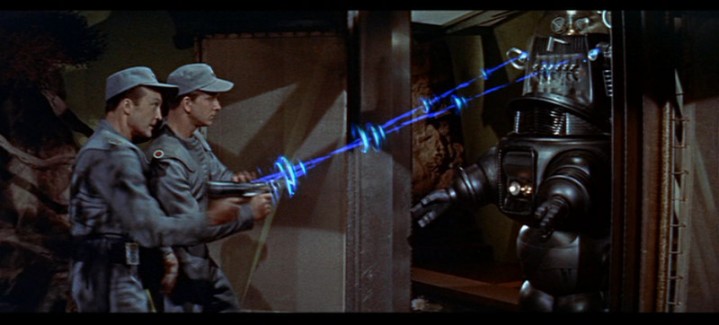
The films major positives are its decisively awesome visual effects. An opening sequence eclipse sets the tone for the rest of the film, with a truly remarkable realism intertwined with outright fantasy in equal measure, all bought with the best Hollywood effects money can buy. The main ship itself, the C57-D, is a typical flying-saucer-on-a-wire effort, but when it lands on Altair IV, the massive soundstage set is eye-popping in its scale and detail. The painted backdrops accompanying the massive sets are equally impressive, the alien landscape being front and centre of the visual style in this entire production. The use of matting to insert differing scenes within each other – such as a sequence where Morbius leads Adams and his men around the cavernous Krell labyrinth and they are dwarfed by the machines – is impressively done, and almost invisible even to modern eyes. The sequences with the invisible monster are also spanking efforts for the time – part animation, part live action practical effects, the Monster is terrifying even today. I know it scared the crap out of me as a kid. Technically, this film is a marvel to behold. Equally as impressive is the screen debut of robot Robby, the lumbering, cumbersome mechanical butler for Morbius and Alta – he’s representative of the highest design thinking and technical skill, according to the films extensively fact-driven dialogue, and yet I think he couldn’t beat a one-legged man in a footrace over any distance! Kids of the day would have gone gaga over this technological marvel, no doubt, but in the years since, he’s kind of outdated. I’ve got more technology in my cellphone than Robby does in his entire body, I think. Don’t let this films vintage fool you, though. This is old-school technical wizardry, long before 2001: A Space Odyssey or Star Wars came on the scene – yet Forbidden Planet had an impact on both those films, that much is certain.
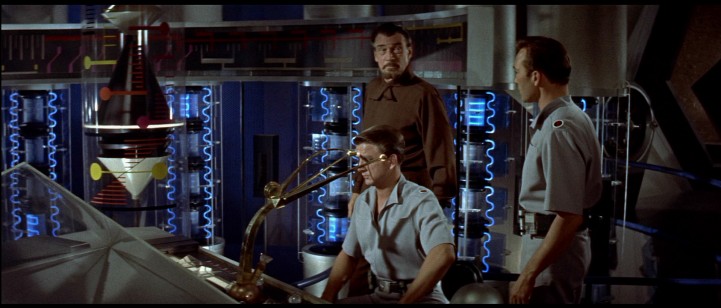
If there’s one creative facet of Forbidden Planet I’d say was the most annoying, it’s the films electronic score, composed by Louis and Bebe Barron. The Barrons were renowned for their electronic music, and virtually pioneered the artform, but I have to say, it’s not to my taste. In fact, as its used in almost the entirety of the film, it starts to get a little grating – and by that I mean its very, very annoying. The screeching, wah-wah techno-squeals of this “score” might have felt apropos to the story and science-y feel of the movie, but as an aural accompaniment, it’s hard to listen to. It reminds me a lot of the old 70’s Doctor Who incidental music, for those seeking further clarification. A lot of stuff and nonsense, and annoying to boot.
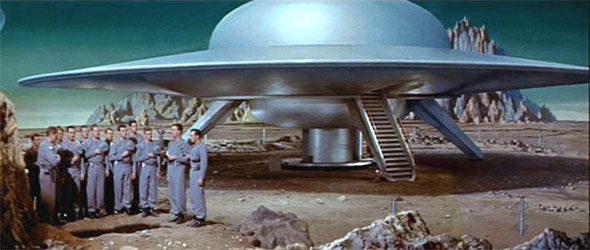
As a milestone of science fiction, Forbidden Planet is right up there in the pantheon. As a work of creative fiction, it’s certainly got a lot to say (a lot of the subtext was lost on me, I’m sure, but I think it’s got to do with man’s self-destructive nature, when you boil it down) to audiences willing to listen, and the star turn of Nielsen and Francis are easily the best part of the whole shebang. At times scary, at times clunky and decidedly 50’s, and more often than not weirdly fantastical, the film remains a true star when the visual effects and scope of the story start to unfold. Forbidden Planet is worth a look for fans of good sci-fi, and for folks keen to sample the best Hollywood had to offer at the time.


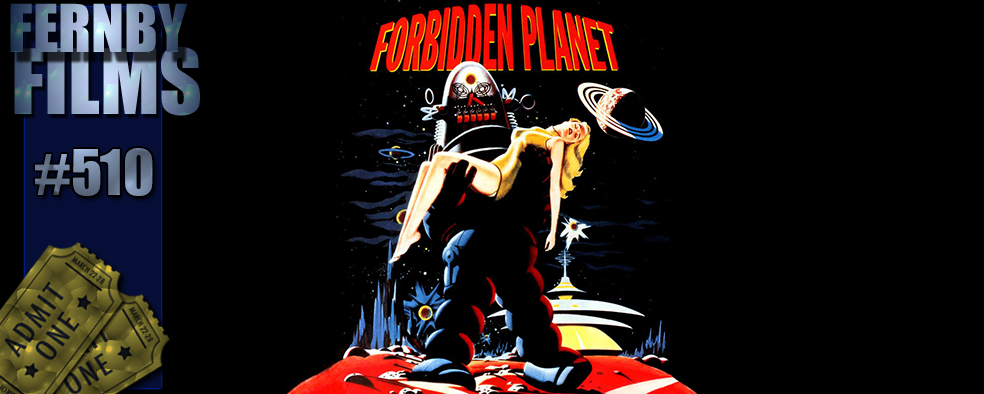
Egad–calling the film's electronic score "annoying" is like saying that the Sistine Chapel is pretty nice except for that garish ceiling. The electronic score was revolutionary and indisputably seminal. It also gives the film an edge that survives today. If MGM had done the usual orchestral fluff, the movie would not be nearly as gripping and original as it is.
Fair point, Glenn, about the film not being same without that electronic score, and it was indeed revolutionary, but I couldn\’t get past the score\’s weird, meandering, strident lack of emotion. Music (or score) should enhance the film, accentuate it, either through mood or energy or offering a tangible mental link between sound and image, and I have to be honest in saying Forbidden Planet\’s score did nothing of the sort. Perhaps I\’m a generation too late to really appreciate it, or maybe (more likely) I\’m too accustomed to contemporary orchestral or electronic work (such as Hans Zimmer, as an example) to apprciate the subtlety of this films score. Either way, I can\’t say I found it anything other than annoying, so annoying it is. Horses for courses, naturally.
It is crazy and fun and visually stunning for its time. This is definitely one of those sci-fi's held up by buffs as quintessential cinema within the genre.
My recent post Top 10 British Sports Films
Considering how dated it looks and feels, it still resonates, doesn't it Dan!